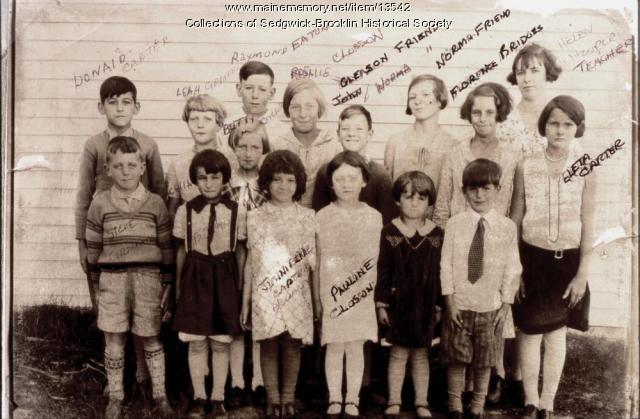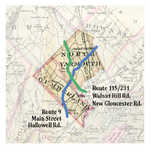Keywords: Population
Item 21192
Building of Arts in Bar Harbor, ca. 1915
Contributed by: Bar Harbor Historical Society Date: circa 1915 Location: Bar Harbor Media: Postcard
Item 21315
Building of Arts, Bar Harbor, ca. 1925
Contributed by: Acadia National Park Date: circa 1925 Location: Bar Harbor Media: Photographic print
Exhibit
Biddeford, Saco and the Textile Industry
The largest textile factory in the country reached seven stories up on the banks of the Saco River in 1825, ushering in more than a century of making cloth in Biddeford and Saco. Along with the industry came larger populations and commercial, retail, social, and cultural growth.
Exhibit
Reading, Writing and 'Rithmetic: Brooklin Schools
When Brooklin, located on the Blue Hill Peninsula, was incorporated in 1849, there were ten school districts and nine one-room school houses. As the years went by, population changes affected the location and number of schools in the area. State requirements began to determine ways that student's education would be handled. Regardless, education of the Brooklin students always remained a high priority for the town.
Site Page
Cumberland & North Yarmouth - Population Decline in Maine's Coastal Counties
"The following decade, the state registered a decline in population of two-tenths percent, to 626,915."
Site Page
Brewer is the gateway to coastal communities and Acadia National Park. The city along with Bangor also serves as a trading and distribution center for the coastal areas and towns and cities to the north with the total region having a population of approximately 250,000 people.
Story
Why I came to Maine and what's kept me here
by Kate Webber
I came to Maine for college but then got involved in contradance and museums.
Story
Cape Verde and the Doctrines of Discovery
by Lelia DeAndrade
My Cape Verde family's culture and history is tied to the Doctrines of Discovery
Lesson Plan
What Remains: Learning about Maine Populations through Burial Customs
Grade Level: 6-8
Content Area: English Language Arts, Social Studies, Visual & Performing Arts
This lesson plan will give students an overview of how burial sites and gravestone material culture can assist historians and archaeologists in discovering information about people and migration over time. Students will learn how new scholarship can help to dispel harmful archaeological myths, look into the roles of religion and ethnicity in early Maine and New England immigrant and colonial settlements, and discover how to track changes in population and social values from the 1600s to early 1900s based on gravestone iconography and epitaphs.
Lesson Plan
Portland History: Lemuel Moody and the Portland Observatory
Grade Level: 3-5
Content Area: Social Studies
Lemuel Moody and the Portland Observatory Included are interesting facts to share with your students and for students, an interactive slide show available on-line at Maine Memory Network. The "Images" slide show allows students to place historical images of the Observatory in a timeline. Utilizing their observation skills students will place these images in chronological order by looking for changes within the built environment for clues. Also available is the "Maps" slide show, a series of maps from key eras in Portland's history. Students will answer the questions in the slide show to better understand the topography of Portland, the need for an Observatory and the changes in the landscape and the population centers.
















